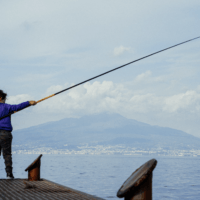 Despite his reputation as a progressive pope and a hero of the oppressed, Pope Francis' involvement in Argentina's Dirty War haunted him. read now…
Despite his reputation as a progressive pope and a hero of the oppressed, Pope Francis' involvement in Argentina's Dirty War haunted him. read now…
This post was originally published on Independent Australia.
 Despite his reputation as a progressive pope and a hero of the oppressed, Pope Francis' involvement in Argentina's Dirty War haunted him. read now…
Despite his reputation as a progressive pope and a hero of the oppressed, Pope Francis' involvement in Argentina's Dirty War haunted him. read now…
This post was originally published on Independent Australia.































































Photograph Source: שי קנדלר – CC BY-SA 4.0
Universities are in a bind. As institutions of learning and teaching, knowledge learnt and taught should, or at the very least could, be put into practice. How unfortunate for rich ideas to linger in cold storage or exist as the mummified status of esoterica. But universities in the United States have taken fright at pro-Palestinian protests since October 7, 2023, becoming battlegrounds for the propaganda emissaries of Israeli public relations and the pro-evangelical, Armageddon lobby that sees the end times taking place in the Holy Land. Higher learning institutions are spooked by notions of Israeli brutality, and they are taking measures.
These measures have tended to be heavy handed, taking issue with students and academic staff. The policy has reached another level in efforts by amphibian university managers to ban various protest groups who are seen as creating an environment of intimidation for other members of the university tribe. That these protesters merely wish to draw attention to the massacre of Palestinian civilians, including women, children, and the elderly, and the fact that the death toll, notably in the Gaza Strip, now towers at over 50,000, is a matter of inconvenient paperwork.
Even worse, the same institutions are willing to tolerate individuals who have celebrated their own unalloyed bigotry, lauded their own racial and religious ideology, and deemed various races worthy of extinguishment or expulsion. Such a man is Israel’s National Security Minister Itamar Ben-Gvir, who found himself permitted to visit Yale University at the behest of the Jewish society Shabtai, a body founded by Democratic senator and Yale alumnus Cory Booker, along with Rabbi Shmully Hecht.
Shabtai is acknowledged as having no official affiliation with Yale, though it is stacked with Yale students and faculty members who participate at its weekly dinners. Its beating heart was Hecht, who arrived in New Haven after finishing rabbinical school in Australia in 1996.
The members of Shabtai were hardly unanimous in approving Ben-Gvir’s invitation. David Vincent Kimel, former coach of the Yale debate team, was one of two to send an email to a Shabtai listserv to express brooding disgruntlement. “Shabtai was founded as a space for fearless, pluralistic Jewish discourse,” the email remarks. “But this event jeopardizes Shabtai’s reputation and every future.” In views expressed to the Jewish Telegraphic Agency, Kimel elaborated: “I’m deeply concerned that we’re increasingly treating extreme rhetoric as just another viewpoint, rather than recognizing it as a distortion of constructive discourse.” The headstone for constructive discourse was chiselled sometime ago, though Kimel’s hopes are charming.
As a convinced, pro-settler fanatic, Ben-Gvir is a fabled-Torah basher who sees Palestinians as needless encumbrances on Israel’s righteous quest to acquire Gaza and the West Bank. Far from being alone, Ben-Gvir is also the member of a government that has endorsed starvation and the deprivation of necessities as laudable tools of conflict, to add to an adventurous interpretation of the laws of war that tolerates the destruction of health and civilian infrastructure in the Gaza Strip.
After a dinner at President Donald Trump’s Mar-a-Lago resort (the bad will be fed), Ben-Gvir was flushed with confidence. He wrote on social media of how various lawmakers had “expressed support for my very clear position on how to act in Gaza and that the food and aid depots should be bombed in order to create military and political pressure to bring our hostages home safely.” By any other standard, this was an admission to encouraging the commission of a war crime.
In July last year, Israel’s State Prosecutor Amit Aisman reportedly sought permission from Attorney General Gali Baharav-Miara to open a criminal investigation into Ben-Gvir for alleged incitement of violence against residents of Gaza. The move was said to be a gesture to placate the International Court of Justice as it considers the genocide case filed by South Africa against Israel over the war in Gaza. In a string of increasingly agitated interim orders, the ICJ has asked that Israel comply, as signatory member, with the obligations imposed by the United Nations Genocide Convention. These include prohibitions against incitement to genocide.
Incitement has become something of a nervous tic for the minister. In November 2023, for instance, Ben-Gvir remarked that “When we say Hamas should be destroyed, it also means those who celebrate, those who support, and those who hand out candy – they’re all terrorists, and they should also be destroyed.” Seeing himself as essentially immune to any form of prosecution, Ben-Gvir gave the State Prosecutor a sound verbal thrashing, claiming that it was “trying to make an Israeli minister stand trial for ‘incitement’ against citizens of an enemy state that danced on the blood our soldiers on the streets of Gaza on October 7.”
In a statement responding to protests against Ben-Gvir’s visit, Yale stated that the student encampments set up on April 22 on Beinecke Plaza were in violation of the university’s policies on the use of outdoor spaces. Students already on notice for previous protests along similar lines would face “immediate disciplinary action”. With dulling predictability, the university revealed that it was looking into “concerns … about disturbing anti-Semitic conduct at the gathering”.
University officialdom had also focused on the activities of Yalies4Palestine, a student organisation whose club status was revoked for “sending calls over social media for others to join the event”. The statement makes the claim that the group “flagrantly violated the rules to which the Yale College Dean’s Office holds all registered student organizations”. Consequently, the body cannot receive funding from Yale sources, use the university name, participate in relevant student activities, or book spaces on the campus.
This profaning of protest in a university setting is a convenient trick, using the popular weasel words of “offensive” and “unsafe” while deploying, more generically, the pitiful policy inventory that makes freedom of expression an impossibility. Mobilised accordingly, they can eliminate any debate, any discussion and any idea from the campus for merely being stingingly contrarian or causing twinges of intellectual discomfort. The moment the brain aches in debate, the offended howl and the administrators suppress. Play nice, dear university staff and students, or don’t play at all. Besides, Ben-Gvir, by Yale standards, is a half-decent fellow.
The post Yale, Ben-Gvir and Banning Palestinian Groups appeared first on CounterPunch.org.
This post was originally published on CounterPunch.org.
Universities are in a bind. As institutions of learning and teaching, knowledge learnt and taught should, or at the very least could, be put into practice. How unfortunate for rich ideas to linger in cold storage or exist as the mummified status of esoterica. But universities in the United States have taken fright at pro-Palestinian protests since October 7, 2023, becoming battlegrounds for the propaganda emissaries of Israeli public relations and the pro-evangelical, Armageddon lobby that sees the end times taking place in the Holy Land. Higher learning institutions are spooked by notions of Israeli brutality, and they are taking measures.
These measures have tended to be heavy handed, taking issue with students and academic staff. The policy has reached another level in efforts by amphibian university managers to ban various protest groups who are seen as creating an environment of intimidation for other members of the university tribe. That these protesters merely wish to draw attention to the massacre of Palestinian civilians, including women, children, and the elderly, and the fact that the death toll, notably in the Gaza Strip, now towers at over 50,000, is a matter of inconvenient paperwork.
Even worse, the same institutions are willing to tolerate individuals who have celebrated their own unalloyed bigotry, lauded their own racial and religious ideology, and deemed various races worthy of extinguishment or expulsion. Such a man is Israel’s National Security Minister Itamar Ben-Gvir, who found himself permitted to visit Yale University at the behest of the Jewish society Shabtai, a body founded by Democratic senator and Yale alumnus Cory Booker, along with Rabbi Shmully Hecht.
Shabtai is acknowledged as having no official affiliation with Yale, though it is stacked with Yale students and faculty members who participate at its weekly dinners. Its beating heart was Hecht, who arrived in New Haven after finishing rabbinical school in Australia in 1996.
The members of Shabtai were hardly unanimous in approving Ben-Gvir’s invitation. David Vincent Kimel, former coach of the Yale debate team, was one of two to send an email to a Shabtai listserv to express brooding disgruntlement. “Shabtai was founded as a space for fearless, pluralistic Jewish discourse,” the email remarks. “But this event jeopardizes Shabtai’s reputation and every future.” In views expressed to the Jewish Telegraphic Agency, Kimel elaborated: “I’m deeply concerned that we’re increasingly treating extreme rhetoric as just another viewpoint, rather than recognizing it as a distortion of constructive discourse.” The headstone for constructive discourse was chiselled sometime ago, though Kimel’s hopes are charming.
As a convinced, pro-settler fanatic, Ben-Gvir is a fabled-Torah basher who sees Palestinians as needless encumbrances on Israel’s righteous quest to acquire Gaza and the West Bank. Far from being alone, Ben-Gvir is also the member of a government that has endorsed starvation and the deprivation of necessities as laudable tools of conflict, to add to an adventurous interpretation of the laws of war that tolerates the destruction of health and civilian infrastructure in the Gaza Strip.
After a dinner at President Donald Trump’s Mar-a-Lago resort (the bad will be fed), Ben-Gvir was flushed with confidence. He wrote on social media of how various lawmakers had “expressed support for my very clear position on how to act in Gaza and that the food and aid depots should be bombed in order to create military and political pressure to bring our hostages home safely.” By any other standard, this was an admission to encouraging the commission of a war crime.
In July last year, Israel’s State Prosecutor Amit Aisman reportedly sought permission from Attorney General Gali Baharav-Miara to open a criminal investigation into Ben-Gvir for alleged incitement of violence against residents of Gaza. The move was said to be a gesture to placate the International Court of Justice as it considers the genocide case filed by South Africa against Israel over the war in Gaza. In a string of increasingly agitated interim orders, the ICJ has asked that Israel comply, as signatory member, with the obligations imposed by the United Nations Genocide Convention. These include prohibitions against incitement to genocide.
Incitement has become something of a nervous tic for the minister. In November 2023, for instance, Ben-Gvir remarked that “When we say Hamas should be destroyed, it also means those who celebrate, those who support, and those who hand out candy – they’re all terrorists, and they should also be destroyed.” Seeing himself as essentially immune to any form of prosecution, Ben-Gvir gave the State Prosecutor a sound verbal thrashing, claiming that it was “trying to make an Israeli minister stand trial for ‘incitement’ against citizens of an enemy state that danced on the blood our soldiers on the streets of Gaza on October 7.”
In a statement responding to protests against Ben-Gvir’s visit, Yale stated that the student encampments set up on April 22 on Beinecke Plaza were in violation of the university’s policies on the use of outdoor spaces. Students already on notice for previous protests along similar lines would face “immediate disciplinary action”. With dulling predictability, the university revealed that it was looking into “concerns … about disturbing anti-Semitic conduct at the gathering”.
University officialdom had also focused on the activities of Yalies4Palestine, a student organisation whose club status was revoked for “sending calls over social media for others to join the event”. The statement makes the claim that the group “flagrantly violated the rules to which the Yale College Dean’s Office holds all registered student organizations”. Consequently, the body cannot receive funding from Yale sources, use the university name, participate in relevant student activities, or book spaces on the campus.
This profaning of protest in a university setting is a convenient trick, using the popular weasel words of “offensive” and “unsafe” while deploying, more generically, the pitiful policy inventory that makes freedom of expression an impossibility. Mobilised accordingly, they can eliminate any debate, any discussion and any idea from the campus for merely being stingingly contrarian or causing twinges of intellectual discomfort. The moment the brain aches in debate, the offended howl and the administrators suppress. Play nice, dear university staff and students, or don’t play at all. Besides, Ben-Gvir, by Yale standards, is a half-decent fellow.
The post Yale, Ben-Gvir, and Banning Palestinian Groups first appeared on Dissident Voice.This post was originally published on Dissident Voice.
The very idea of infallibility sets one up for the mighty fall. But the Pope, temporal head of all Catholics, is one such character, the papacy one such institution, arrogantly paraded before religion, faith and principle, as an individual and office hovering between humankind and God. Unfortunately for the papal record, infallibility in any spiritual sense is no guard against spotty records and stains. It certainly does not erase what came before, though good efforts are often made to reinvent it.
Pope Francis I, eulogised as the pontiff of the periphery and the oppressed, was not averse in his pre-papal iteration to courting the powerful and the authoritarian when a US-backed military dictatorship seized power in his native Argentina in 1976. That dictatorship, responsible for the forced disappearance of 30,000 people, came to be known as the Proceso de Reorganización Nacional (National Reorganization Process). In 1978, on a visit to Buenos Aires to attend the football World Cup as dictator Jorge Videla’s guest, former US National Security Adviser and Secretary of State Henry Kissinger was filled with praise for the murderous methods of the Proceso in its efforts to combat “terrorism”.
On their seizure of power, the junta were also keen to grease palms and cultivate ties with the Catholic Church. Archbishop Adolfo Tortolo obligated, urging Argentinians “to cooperate in a positive way with the new government.” Argentina’s bishops also issued a statement declaring that the security services could hardly act “with the chemical purity” expected of them in times of peace. Some freedom had to be shorn. Church figures who did not play along, such as Enrique Angelelli, the bishop of the Andean diocese of La Rioja, were murdered. In a 2012 interview, Videla expressed satisfaction at Church-state relations during his rule. “My relationship with the church was excellent. It was very cordial, frank and open.”
To say, for one thing, that Francis had that progressive rainbow in soul and practice is to ignore the same figure who encouraged Jesuit priests under his charge to focus on religion rather than matters of social deprivation. As Jose Mario Bergoglio, Provincial of the Jesuits, he removed teachers of the more progressive stripe and replaced them with steelier, austere types. He shunned the liberation theologians, clinging on to the 1969 Declaration of San Miguel that gave the cold shoulder to Marxism in favour of a rather vague theology of the masses. Paul Vallely writes that the late Francis “seemed unaware of any of the teachings of Vatican II. It was all St. Thomas Aquinas and the old Church Fathers. We didn’t study a single book by Gutiérrez, Boff or Paulo Freire”. (Those three figures were very much front and centre of liberation theology.)
The disavowal of priestly work in the slums of Buenos Aires as Provincial of the Jesuits had its consequences. Orlando Yorio, a Jesuit priest doing just such work, was conveyed in 1976 to the dark offices of the military junta by then Father Jorge Mario Bergoglio’s seeming refusal to back, endorse or acknowledge the labours that the military regime despised. The same fate befell Franz Jalics. In the first trial of the junta leadership in 1985, Yorio was convinced “that he himself [Bergoglio] gave over the list with our names to the Navy.” Jalics, however, stated in March 2013 that Bergoglio had never “denounced” either himself or Yorio. Both priests had been kidnapped for connections to a catechist who “later joined the guerillas.”
At the time of his election in 2013, the Vatican made a point of stating that, in the words of spokesman Fr Federico Lombardi, there had “never been any credible, concrete accusation against him.”
In other instances during that most dirty of wars, Fr Bergoglio does not seem to acquit himself well. Estela de la Cuadra, who shared little in the way of enthusiasm for Cardinal Bergoglio’s elevation to pontiff, suggests that he knew far more about what was taking place in the 1970s than what he subsequently testified to. In a trial in 2010, the then Cardinal was asked to attend a trial on the infamous “stolen babies” cases, a spectacularly unsavoury matter involving the handing over of infants from murdered mothers to military families. Unconvincingly, he claimed to only know of the practice once Argentina moved into the calmer, less murderous waters of democracy after 1983.
De la Cuadra is all rebuttal, claiming that her father had been advised by the then Fr Bergoglio to meet a bishop who might advise him on the fate of the disappearance of his pregnant daughter Elena. The bishop was, at best, callously helpful, informing him that “his granddaughter was ‘now with a good family’.”
The ventures to investigate and tease out Bergoglio’s legacy during the Proceso remain a matter of record. Investigations by scribblers in 1986 and 2003, carried out respectively by Emilio Mignone and Horacio Verbitsky, attest to that. (Verbitsky’s account is further spiced by llegations that he was himself on the junta’s payroll, working as ghost writer for Brigadier Omar Domingo Rubens Graffigna.)
Bergoglio’s disputed dance with the junta continues that extensive tradition perfected by the Catholic Church. A power, however ruthless in the secular realm, should still be accommodated by the spiritual leaders of the church if the adherents of said power are sympathetic followers of Rome. “Never in the years he headed the Catholic Church in Argentina did he acknowledge its complicity in the dictatorship, much less ask for forgiveness,” blazed Gabriel Pasquini, editor of El Puercoespín, in 2015.
The argument for the defence has tended to be framed along the lines of internal church politics, misunderstanding, and indignant claims of slander. There were Jesuits who took issue with him, for instance, for selling the Universidad del Salvador to the Iron Guard, a right wing order characterised by an unflappable ascetic. And when Bergoglio met with such bloodthirsty thugs as Videla and Emilio Massera, this was only to intercede on behalf of the detained clerics and others to seek their release. “He was very critical of the dictatorship,” asserts former Argentine judge and acquaintance, Alicia Oliveira. He really meant well. It is precisely in that meaning that questions have been and should be asked. To what extent should the powerful be pleased by the supposedly spiritual?
The post Fallibility, Dirty Wars, and Pope Francis I first appeared on Dissident Voice.































































Photograph Source: https://www.flickr.com/people/45644610@N03 – CC BY-SA 3.0
Few armed forces have managed to make murder and executions the stuff of procedural aberration rather than intentional practice. Killing civilians and unarmed personnel is the stuff of misreading and misunderstandings, albeit arrived at with good conscience. And so it was that the killing of 15 aid and emergency workers in Gaza by the Israeli Defense Forces on March 23 could be put down to “professional failures, breaches or orders and a failure to fully report the incident”, a finding identified by an investigation conducted by the same organisation into its own personnel.
In marking its own report card, and giving it a credible pass, the IDF found, using the dulling terms that make murder an afterthought, that the deaths were of minor if regretful consequence. While not explicitly libelling the dead workers, the official press release teeters on excuse and general exculpation, making it clear that, on March 23, “the troops were conducting a vital mission aimed at targeting terrorists.” The killings took place “in a hostile and dangerous combat zone, under a widespread threat to the operating troops.” The armed forces were presented with the dilemma of protecting medical and facilities (something the IDF has conspicuously failed to do), with the use by Hamas “of such infrastructure for terrorism, including ambulances to transport terrorists and weapons.”
The thick insinuation that the aid workers were more or less asking for it by being there in the first place emerges with unadorned rawness. And to suggest claims of execution or the bounding of any of the murdered before or after shooting were “blood libels and false accusations against IDF soldiers.”
The IDF press release leaves an impression of forced thoroughness. There had been “extensive data collection from operational systems, the forces on the ground, and along the entire chain of command.” This had also included “relevant operational orders and directives, footage from various surveillance systems active during the event, radio recordings.” There was even a reconstruction of the events, the personnel involved questioned.
The inquiry identified three shooting incidents: the first involving troops firing on an alleged Hamas vehicle; the second, involving firing on a fire truck and ambulances close to the area where the troops were operating after the deputy battalion commander identified the vehicles as “employed by Hamas forces, who arrived to assist the first vehicle’s passengers”; and the third involving an attack by the IDF on a Palestinian UN vehicle “due to operational errors in breach of regulation.”
The inquiry did little to consider the damning evidence arising from a video of one of the slain workers, Red Crescent paramedic Rifaat Radwan, which prompted the IDF to change its initially fabricated story: that the vehicles had stealthily approached them without lights or markings in the menacing dark. It is hard to imagine, for instance, that “the deputy commander did not initially recognize the vehicles as ambulances” given “poor night visibility”. The vehicles were illuminated, the markings palpably visible. But no matter: of the fifteen Palestinians butchered that night, six were Hamas terrorists. None were armed, but that hardly mattered.
As for the subsequent gruesome treatment of the bodies, the inquiry also finds little fault. The battalion’s covering of the aid workers in shallow graves was intended “to prevent further harm” (well, they were dead, the harm well and truly done) while clearing the vehicles to allow “civilian evacuation”, another euphemism used by the public relations arm of the IDF to justify expulsions and displacement. Removing the bodies was deemed “reasonable”; the crushing of the vehicles, suggesting the workings of guilty minds, was not. There had been no intention to “to conceal the event, which was discussed with international organizations and the UN, including coordination for the removal of the bodies.”
In watering down the murderous significance of the killings, the matter of failings, breach of orders and inadequate reporting are eclipsed by the continued commitment to battle Hamas “while upholding IDF values, operational discipline and orders.” The Golani Reconnaissance Battalion had acquitted itself well, “operating with great distinction for a year and a half.” Troops had opened fire on “suspects […] after perceiving an immediate and tangible threat.” This is what happens when students grade their own papers, without invigilation and supervision by an independent authority.
The consequence of the inquiry will be mild and, as the entire process has proven to be, bureaucratic in its self-justification. The execution of 15 Palestinian emergency workers on the blood ledger will get you the dismissal of a battalion deputy commander for “incomplete and inaccurate reporting” and a reprimand for a brigade commanding officer, in this case the 14th Brigade. It’s a calculus fantastically obscene, but it is one repeatedly used in various forms when it comes to slaying Palestinians and those who fall victim to the doctrine of expansive force taken by Israel after October 7, 2023.
The post Euphemistic Practices: The IDF, Killing Aid Workers and Self-Investigation appeared first on CounterPunch.org.
This post was originally published on CounterPunch.org.































































Photograph Source: BAE Systems – OGL 3
It was a deal for the cretinous, hammered out by the less than bright for less than honourable goals. But AUKUS, the trilateral security alliance between Australia, the United Kingdom and the United States, is now finally receiving the broader opprobrium it should have had from the outset. Importantly, criticism is coming from those who have, at points, swooned at the prospect of acquiring a nuclear-powered submarine capability assuming, erroneously, that Australia somehow needs it.
The post Dotty and Cretinous: Reviewing AUKUS appeared first on CounterPunch.org.
This post was originally published on CounterPunch.org.































































Photograph Source: User:שועל, modified by User:MathKnight – File:IDF Caterpillar D9 in action.JPG – CC BY-SA 3.0
In recent months, the Israeli Defense Forces have been much taken by a term that augurs poorly for peaceful accord in the Middle East.“Security zones” are being seized in the Gaza Strip, Lebanon and Syria.Land is, for claimed reasons of self-defence, being appropriated with brazen assuredness.It is hard, however, to see this latest turn as anything other than a de facto military occupation, a situation that will prolong the crisis of vulnerability the Jewish state so wishes to overcome.Israel’s insecurities are much the result of various expansions since 1948 that have only imperilled it to future attack and simmering acrimony.The pattern threatens to repeat itself.
The post De Facto Occupation: Israel’s Security Zone Strategy appeared first on CounterPunch.org.
This post was originally published on CounterPunch.org.
It was a deal for the cretinous, hammered out by the less than bright for less than honourable goals. But AUKUS, the trilateral security alliance between Australia, the United Kingdom and the United States, is now finally receiving the broader opprobrium it should have had from the outset. Importantly, criticism is coming from those who have, at points, swooned at the prospect of acquiring a nuclear-powered submarine capability assuming, erroneously, that Australia somehow needs it.
A report by the Strategic Analysis Australia think tank has found that AUKUS, despite the increasingly vain promise of supplying the Royal Australian Navy with nuclear powered submarines in 2032, has already become its own, insatiable beast. As beast it is, with the cost over the next four years for the submarine program coming in at A$17.3 billion, exceeding by some margin the capital budget of the Royal Australian Airforce (RAAF) at A$12.7 billion. One of the authors of the report, Marcus Hellyer, notes that “in terms of acquisition spending, the SSN [nuclear-powered attack submarine] enterprise has already become the ADF’s [Australian Defence Force’s] ‘fourth service’.”
The report notes some remarkable figures. Expenditure on SSNs is estimated to be somewhere between A$53 billion and A$63 billion between 2024-2034, with the next five years of the decade costing approximately A$20 billion. The amount left over for the following years comes in at $33 to $44 billion, necessitating a target of $10 billion annually by the end of the financial decade in the early 2030s. What is astounding is the amount being swallowed up by the ADF’s investment program in maritime capabilities, which will, over the coming decade, come to 38% of the total investment.
The SSN program has made its fair share in distorting the budget. The decade to 2033-4 features a total budget of A$330 billion. But the SSN budget of $53-63 billion puts nuclear powered submarines at 16.1% to 19.1% more than either the domains of land and air relevant to Australia’s defence. “It’s hard to grasp how unusual this situation is,” the report notes with gravity. “Moreover, it’s one that will endure for decades, since the key elements of the maritime domain (SSNs and the two frigate programs) will still be in acquisition well into the 2040s. It’s quite possible that Defence itself doesn’t grasp the situation that it’s gotten into.”
To add to the more specialist literature calling large parts of AUKUS expenditure into question comes the emergence of disquiet in political ranks. Despite the craven and cowardly bipartisan approval of Australia’s dottiest military venture to date, former Labor senator Doug Cameron, who fronts the Labor Against War group, is a symptom of growing dissent. “There are other more realistic and cost-effective strategies to protect our territorial integrity without subjugating ourselves to a dangerous, unpredictable and unworthy Trump administration.”
On the other side of the political aisle, former Liberal Prime Minister Malcolm Turnbull is pessimistically inclined to the view that Australia will never get those much heralded submarines. “There will be Australian sailors serving on US submarines, and we’ll provide them with a base in Western Australia.” Furthermore, Australia would have “lost both sovereignty and security and a lot of money as well.”
The spineless disposition of Australia’s political cadres may prove irrelevant to the forced obsolescence of the agreement, given the scrutiny of AUKUS in both the United States and the United Kingdom. The pugilistic nature of the tariff system imposed by the Trump administration on all countries, friendly or adversarial, has brought particular focus on the demands on naval and submarine construction. Senior Democrat on the Senate Armed Services Subcommittee, Virginia Senator Tim Kaine, told an AUKUS dinner in Washington this month that “We are already having trouble getting these ships and subs on time [and] on budget. Increase those prices – it’s going to be a problem.”
Taine’s point is logical enough, given that steel and aluminium have been targeted by particularly hefty rates. Given the array of products requiring exchange in the AUKUS arrangement, tariffs would, the senator reasons, “slow us down and make things harder”.
Another blow also looms. On April 9, the White House ordered the Department of Government Efficiency (DOGE) to comb through the procurement of US Navy vessels in order “to improve the efficiency and effectiveness of these processes” and contribute to the Trump administration’s Maritime Action Plan. Consistent with Trump’s near obsession of reviving national industry, the order seeks “to revitalize and rebuild domestic maritime industries and workforce to promote national security and economic prosperity.”
Australian taxpayers have every reason to be further worried about this, given the order’s emphasis that US departments and agencies pursue “all available incentives to help shipbuilders domiciled in allied nations partner to undertake capital investment in the US to help strengthen the shipbuilding capacity of the US”. Given that that US submarine industrial base is already promised $US3 billion from Australia’s pockets, with $500 million already transferred in February, the delicious exploitation of Canberra’s stupidity continues apace.
In the UK, the House of Commons Defence Committee this month announced a parliamentary inquiry into the defence pact, which will evaluate the agreement in light of changes that have taken place since 2021. “AUKUS has been underway for three years now,” remarked Defence Committee chairman and Labour MP, Tan Dhesi. “The inquiry will examine the progress made against each of the two pillars, and ask how any challenges could be addressed.”
The first pillar, perennially spectral, stresses the submarine component, both in terms of transferring Virginia class SSNs to Australia and the construction of a bespoke nuclear-powered AUKUS submarine; the second focuses on the technological spread of artificial intelligence, quantum capabilities, hypersonic advances and cyber warfare. While Dhesi hopes that the inquiry may throw up the possibility of expanding the second pillar, beady eyes will be keen to see the near non-existent state regarding the first. But even the second pillar lacks definition, prompting Kaine to suggest the need for “some definition and some choices”. Nebulous, amorphous and foolish, this absurd pact continues to sunder.
The post Reviewing AUKUS first appeared on Dissident Voice.This post was originally published on Dissident Voice.
It was a deal for the cretinous, hammered out by the less than bright for less than honourable goals. But AUKUS, the trilateral security alliance between Australia, the United Kingdom and the United States, is now finally receiving the broader opprobrium it should have had from the outset. Importantly, criticism is coming from those who have, at points, swooned at the prospect of acquiring a nuclear-powered submarine capability assuming, erroneously, that Australia somehow needs it.
A report by the Strategic Analysis Australia think tank has found that AUKUS, despite the increasingly vain promise of supplying the Royal Australian Navy with nuclear powered submarines in 2032, has already become its own, insatiable beast. As beast it is, with the cost over the next four years for the submarine program coming in at A$17.3 billion, exceeding by some margin the capital budget of the Royal Australian Airforce (RAAF) at A$12.7 billion. One of the authors of the report, Marcus Hellyer, notes that “in terms of acquisition spending, the SSN [nuclear-powered attack submarine] enterprise has already become the ADF’s [Australian Defence Force’s] ‘fourth service’.”
The report notes some remarkable figures. Expenditure on SSNs is estimated to be somewhere between A$53 billion and A$63 billion between 2024-2034, with the next five years of the decade costing approximately A$20 billion. The amount left over for the following years comes in at $33 to $44 billion, necessitating a target of $10 billion annually by the end of the financial decade in the early 2030s. What is astounding is the amount being swallowed up by the ADF’s investment program in maritime capabilities, which will, over the coming decade, come to 38% of the total investment.
The SSN program has made its fair share in distorting the budget. The decade to 2033-4 features a total budget of A$330 billion. But the SSN budget of $53-63 billion puts nuclear powered submarines at 16.1% to 19.1% more than either the domains of land and air relevant to Australia’s defence. “It’s hard to grasp how unusual this situation is,” the report notes with gravity. “Moreover, it’s one that will endure for decades, since the key elements of the maritime domain (SSNs and the two frigate programs) will still be in acquisition well into the 2040s. It’s quite possible that Defence itself doesn’t grasp the situation that it’s gotten into.”
To add to the more specialist literature calling large parts of AUKUS expenditure into question comes the emergence of disquiet in political ranks. Despite the craven and cowardly bipartisan approval of Australia’s dottiest military venture to date, former Labor senator Doug Cameron, who fronts the Labor Against War group, is a symptom of growing dissent. “There are other more realistic and cost-effective strategies to protect our territorial integrity without subjugating ourselves to a dangerous, unpredictable and unworthy Trump administration.”
On the other side of the political aisle, former Liberal Prime Minister Malcolm Turnbull is pessimistically inclined to the view that Australia will never get those much heralded submarines. “There will be Australian sailors serving on US submarines, and we’ll provide them with a base in Western Australia.” Furthermore, Australia would have “lost both sovereignty and security and a lot of money as well.”
The spineless disposition of Australia’s political cadres may prove irrelevant to the forced obsolescence of the agreement, given the scrutiny of AUKUS in both the United States and the United Kingdom. The pugilistic nature of the tariff system imposed by the Trump administration on all countries, friendly or adversarial, has brought particular focus on the demands on naval and submarine construction. Senior Democrat on the Senate Armed Services Subcommittee, Virginia Senator Tim Kaine, told an AUKUS dinner in Washington this month that “We are already having trouble getting these ships and subs on time [and] on budget. Increase those prices – it’s going to be a problem.”
Taine’s point is logical enough, given that steel and aluminium have been targeted by particularly hefty rates. Given the array of products requiring exchange in the AUKUS arrangement, tariffs would, the senator reasons, “slow us down and make things harder”.
Another blow also looms. On April 9, the White House ordered the Department of Government Efficiency (DOGE) to comb through the procurement of US Navy vessels in order “to improve the efficiency and effectiveness of these processes” and contribute to the Trump administration’s Maritime Action Plan. Consistent with Trump’s near obsession of reviving national industry, the order seeks “to revitalize and rebuild domestic maritime industries and workforce to promote national security and economic prosperity.”
Australian taxpayers have every reason to be further worried about this, given the order’s emphasis that US departments and agencies pursue “all available incentives to help shipbuilders domiciled in allied nations partner to undertake capital investment in the US to help strengthen the shipbuilding capacity of the US”. Given that that US submarine industrial base is already promised $US3 billion from Australia’s pockets, with $500 million already transferred in February, the delicious exploitation of Canberra’s stupidity continues apace.
In the UK, the House of Commons Defence Committee this month announced a parliamentary inquiry into the defence pact, which will evaluate the agreement in light of changes that have taken place since 2021. “AUKUS has been underway for three years now,” remarked Defence Committee chairman and Labour MP, Tan Dhesi. “The inquiry will examine the progress made against each of the two pillars, and ask how any challenges could be addressed.”
The first pillar, perennially spectral, stresses the submarine component, both in terms of transferring Virginia class SSNs to Australia and the construction of a bespoke nuclear-powered AUKUS submarine; the second focuses on the technological spread of artificial intelligence, quantum capabilities, hypersonic advances and cyber warfare. While Dhesi hopes that the inquiry may throw up the possibility of expanding the second pillar, beady eyes will be keen to see the near non-existent state regarding the first. But even the second pillar lacks definition, prompting Kaine to suggest the need for “some definition and some choices”. Nebulous, amorphous and foolish, this absurd pact continues to sunder.
The post Reviewing AUKUS first appeared on Dissident Voice.This post was originally published on Dissident Voice.
In recent months, the Israeli Defense Forces have been much taken by a term that augurs poorly for peaceful accord in the Middle East. “Security zones” are being seized in the Gaza Strip, Lebanon and Syria. Land is, for claimed reasons of self-defence, being appropriated with brazen assuredness. It is hard, however, to see this latest turn as anything other than a de facto military occupation, a situation that will prolong the crisis of vulnerability the Jewish state so wishes to overcome. Israel’s insecurities are much the result of various expansions since 1948 that have only imperilled it to future attack and simmering acrimony. The pattern threatens to repeat itself.
In Syria, Israel rapidly capitalised on the fall of the Assad regime by shredding the status quo. Within a matter of 11 days after the fleeing of the former President Bashar Al-Assad to Moscow, and again on February 1 this year, satellite images showed six military sites being constructed within what is nominally the UN-supervised demilitarised zone, otherwise known as the Area of Separation. A seventh is being constructed outside the zone and in Syria proper. Such busy feats of construction have also accompanied Israeli encroachment on the land of Syrian civilians, coupled with vexing housing raids, road closures and unsanctioned arrests.
All this has taken place despite undertakings from Syria’s transitional President Ahmed al-Sharaa that he would recognise the 1974 agreement made with Israel, one which prohibits Israel from crossing the Alpha Line on the western edge of the Area of Separation. “Syria’s war-weary condition, after years of conflict and war, does not allow for new confrontations,” admitted the new leader on December 14, 2024. Israeli Prime Minister Benjamin Netanyahu was only scornful, regarding the 1974 agreement between the two countries as a dead letter buried by history. “We will not allow any hostile force to establish itself on our border,” he snottily declared.
Lebanon is also facing a stubborn IDF, one that refuses to abide by the Israel-Hezbollah agreement last November which promised the withdrawal of both forces from southern Lebanon, leaving the Lebanese army to take over the supervising reins. Lebanese President Joseph Aoun, who faces the herculean task of removing Hezbollah’s weapons while potentially integrating members of its group into the Lebanese army, has found his task needlessly onerous. In recent discussions with US deputy Mideast envoy Morgan Ortagus, the Lebanese leader reasoned “that Israel’s presence in the five disputed points gives Hezbollah a pretext to keep its weapons.”
On April 16, Israeli Defence Minister Israel Katz promised that such security zones would provide relevant buffers to shield Israeli communities. Ominously, the IDF would “Unlike in the past [not evacuate] areas that have been cleared and seized”. They would “remain in the security zones as a buffer between the enemy and [Israeli] communities in any temporary or permanent situation in Gaza – as in Lebanon and Syria.”
In Gaza, it is becoming increasingly clear that any prospect of Palestinian autonomy or political independence is to be strangled and snuffed out. Israel has already arbitrarily created the “Morag Corridor”, which excises Rafah from the Strip, and the Netzarim Corridor, which severs Gaza in half. Katz has also promised that the policy of blocking all food, medicine and other vital supplies to Gaza implemented on March 2 will continue, as it “is one of the main pressure levers preventing Hamas from using it as a tool with the population”.
Displacement orders, euphemised as “evacuation orders”, have become the staple of operating doctrine, the means of creating buffers of guns and steel. On April 11, Israeli authorities issued two such orders, effectively “covering vast areas in northern and southern Gaza”, according to UN spokesperson Stéphane Dujarric. “Together, these areas span more than 24 square kilometres – roughly the size of everything south of Central Park here in Manhattan.” Within these zones of military seizure lie medical facilities and storage sites filled with vital supplies.
The UN Human Rights office also expressed its concerns about Israel seemingly “inflicting on Palestinians in Gaza conditions of life increasingly incompatible with their continued existence as a group in Gaza.” The population was being “forcibly transferred into ever shrinking spaces with little or no access to life-saving services, including water, food, and shelter, and whey they continue to be subject to attacks.” Engaging in such conduct against a civilian population within an occupied territory, the office pointedly observes, satisfies the definition of a forcible transfer, being both a violation of the Fourth Geneva Convention and a crime against humanity under the Rome Statute of 1998.
The latest doctrine of appropriation and indeterminate occupation adopted by Katz and the IDF has not impressed the Hostages and Missing Families Forum in Israel, long advocating for the release of Israeli hostages still being held in Gaza by Hamas. “They promised that the hostages come before everything,” came the organisation’s aggrieved observation. “In practice, however, Israel is choosing to seize territory before the hostages.” In doing so, the prerogatives of permanent conflict and habitual predation have displaced the more humane prerogatives of peace.
The post De Facto Occupation: Israel’s Security Zone Strategy first appeared on Dissident Voice.This post was originally published on Dissident Voice.































































Photo by Fang Guo
Island states tend to be anxious political entities. Encircled by water, seemingly defended by natural obstacles, the fear of corrupting penetration is never far. Threats of such unwanted intrusion are embellished and magnified. In the case of Australia, these have varied from straying Indonesian fishermen who are seen as terrors of border security, to the threatened establishment of military bases in the Indo-Pacific by China. With Australia facing a federal election, the opportunity to exaggerate the next threat is never far away.
On April 14, the specialist military publication Janes reported that Indonesia had “received an official request from Moscow, seeking permission for Russian Aerospace Forces (VKS) aircraft to be based at a facility in [the country’s] easternmost province.” The area in question is Papua, and the relevant airbase, Biak Numfor, home to the Indonesian Air Force’s Aviation Squadron 27 responsible for operating surveillance aircraft of the CN235 variety.
Indonesian government sources had informed the magazine of a request received by the office of the defense minister, Sjafrie Sjamsoeddin, following a February meeting with the Security Council of the Russian Federation Sergei Shoigu. This was not the first time, with Moscow making previous requests to Jakarta for using a base for its long-range aircraft.
The frazzled response in Australia to the possibility of a Russian presence on Indonesian soil betrays its presumption. Just as Australia would rather not see Pacific Island states form security friendly ties with China, an anxiety directed and dictated by Washington, it would also wish those in Southeast Asia to avoid the feelers of other countries supposedly unfriendly to Canberra’s interests.
Opposition leader, Peter Dutton, who has an addict’s fascination with security menaces of the phantom variety, sprung at the claims made in Janes. “This would be a catastrophic failure of diplomatic relations if [Australian Foreign Minister] Penny Wong and [Prime Minister] Anthony Albanese didn’t have forewarning about this before it was made public,” he trumpeted. “This is a very, very troubling development and suggestion that somehow Russia would have some of their assets based in Indonesia only a short distance from, obviously, the north of our country.”
The Albanese government has tried to cool the confected heat with assurances, with the PM reaffirming Canberra’s support for Ukraine while stating that “we obviously do not want to see Russian influence in our region”. It has also accused Dutton for a streaky fabrication: that Indonesian President Prabowo Subianto had “publicly announced” the details.
Australia’s Defence Minister, Richard Marles, also informed the press that he had spoken to his counterpart Sjamsoeddin, who duly replied “in the clearest possible terms [that] reports of the prospect of Russian aircraft operating from Indonesia are simply not true.”
Besides, a country such as Indonesia, according to Marles, is of the friendly sort. “We have a growing defence relationship with Indonesia. We will keep engaging with Indonesia in a way that befits a very close friend and a very close friendship between our two countries.” This sweetly coated nonsense should have gone out with the façade-tearing acts of Donald Trump’s global imposition of tariffs, unsparing to adversaries and allies alike.
Marles continues to operate in a certain twilight of international relations, under the belief that the defense cooperation agreement with Jakarta “is the deepest level defense agreement we’ve ever had with Indonesia, and we are seeking increasing cooperation between Australia and Indonesia at the defense level.” Whether this is, the case hardly precludes Indonesia, as an important regional power, from conducting defense and foreign policy on its own terms with countries of its own choosing.
In January, Jakarta officially added its name to the BRICS (Brazil, Russia, India, China, South Africa) group, an alternative power alignment that has been foolishly disregarded in terms of significance by the United States and its satellites. Subianto’s coming to power last October has also heralded a warmer turn to Moscow in military terms, with both countries conducting their first joint naval drills last November in the Java Sea near Surabaya. (Indonesia is already a market for Russian fighter jets, despite the cloud of potential sanctions from the US Treasury Department.) For doing so, self-appointed disciplinarians, notably such pro-US outlets as the Australian Strategic Policy Institute, have questioned the country’s fabled non-aligned foreign policy. Engaging Russia in cooperative military terms supposedly undermined, according to the think tank’s publication The Strategist, Jakarta’s “own stated commitment to upholding international law.”
Such commentary is neither here nor there. The Indonesian military remains jealous and proprietary, taking a dim view of any notion of a foreign military base. Retired Major General TB Hasanuddin, who is also a Member of Commission I of the Indonesian House of Representatives, points to constitutional and other legal impediments in permitting such a policy. “Our constitution and various laws and regulations expressly prohibit the existence of foreign military bases.”
Any criticism of Jakarta’s recent gravitation to Moscow also refuses to acknowledge the flexible, even sly approach Indonesia has taken to various powers. It has done so while maintaining a firm independence of mind. In the afterglow of the naval exercises with the Russian Navy, Indonesia’s armed forces merrily went about the business of conducting military exercises with Australia, named Keris Woomera. Between November 13 and 16 last year, the exercise comprised 2,000 personnel from the navy, army and air force from both countries. As Australia frets and fantasizes about the stratagems of distant authoritarian leaders, Indonesia has the last laugh.
The post Flexible and Sly: Indonesian Defense Policy, Russia and Australian Anxiety appeared first on CounterPunch.org.
This post was originally published on CounterPunch.org.
Island states tend to be anxious political entities. Encircled by water, seemingly defended by natural obstacles, the fear of corrupting penetration is never far. Threats of such unwanted intrusion are embellished and magnified. In the case of Australia, these have varied from straying Indonesian fishermen who are seen as terrors of border security, to the threatened establishment of military bases in the Indo-Pacific by China. With Australia facing a federal election, the opportunity to exaggerate the next threat is never far away.
On April 14, the specialist military publication Janes reported that Indonesia had “received an official request from Moscow, seeking permission for Russian Aerospace Forces (VKS) aircraft to be based at a facility in [the country’s] easternmost province.” The area in question is Papua, and the relevant airbase, Biak Numfor, home to the Indonesian Air Force’s Aviation Squadron 27 responsible for operating surveillance aircraft of the CN235 variety.
Indonesian government sources had informed the magazine of a request received by the office of the defence minister, Sjafrie Sjamsoeddin, following a February meeting with the Security Council of the Russian Federation Sergei Shoigu. This was not the first time, with Moscow making previous requests to Jakarta for using a base for its long-range aircraft.
The frazzled response in Australia to the possibility of a Russian presence on Indonesian soil betrays its presumption. Just as Australia would rather not see Pacific Island states form security friendly ties with China, an anxiety directed and dictated by Washington, it would also wish those in Southeast Asia to avoid the feelers of other countries supposedly unfriendly to Canberra’s interests.
Opposition leader, Peter Dutton, who has an addict’s fascination with security menaces of the phantom variety, sprung at the claims made in Janes. “This would be a catastrophic failure of diplomatic relations if [Australian Foreign Minister] Penny Wong and [Prime Minister] Anthony Albanese didn’t have forewarning about this before it was made public,” he trumpeted. “This is a very, very troubling development and suggestion that somehow Russia would have some of their assets based in Indonesia only a short distance from, obviously, the north of our country.”
The Albanese government has tried to cool the confected heat with assurances, with the PM reaffirming Canberra’s support for Ukraine while stating that “we obviously do not want to see Russian influence in our region”. It has also accused Dutton for a streaky fabrication: that Indonesian President Prabowo Subianto had “publicly announced” the details.
Australia’s Defence Minister, Richard Marles, also informed the press that he had spoken to his counterpart Sjamsoeddin, who duly replied “in the clearest possible terms [that] reports of the prospect of Russian aircraft operating from Indonesia are simply not true.”
Besides, a country such as Indonesia, according to Marles, is of the friendly sort. “We have a growing defence relationship with Indonesia. We will keep engaging with Indonesia in a way that befits a very close friend and a very close friendship between our two countries.” This sweetly coated nonsense should have gone out with the façade-tearing acts of Donald Trump’s global imposition of tariffs, unsparing to adversaries and allies alike.
Marles continues to operate in a certain twilight of international relations, under the belief that the defence cooperation agreement with Jakarta “is the deepest level defence agreement we’ve ever had with Indonesia, and we are seeking increasing cooperation between Australia and Indonesia at the defence level.” Whether this is the case hardly precludes Indonesia, as an important regional power, from conducting defence and foreign policy on its own terms with countries of its own choosing.
In January, Jakarta officially added its name to the BRICS (Brazil, Russia, India, China, South Africa) group, an alternative power alignment that has been foolishly disregarded in terms of significance by the United States and its satellites. Subianto’s coming to power last October has also heralded a warmer turn to Moscow in military terms, with both countries conducting their first joint naval drills last November in the Java Sea near Surabaya. (Indonesia is already a market for Russian fighter jets, despite the cloud of potential sanctions from the US Treasury Department.) For doing so, self-appointed disciplinarians, notably such pro-US outlets as the Australian Strategic Policy Institute, have questioned the country’s fabled non-aligned foreign policy. Engaging Russia in cooperative military terms supposedly undermined, according to the think tank’s publication The Strategist, Jakarta’s “own stated commitment to upholding international law.”
Such commentary is neither here nor there. The Indonesian military remains jealous and proprietary, taking a dim view of any notion of a foreign military base. Retired Major General TB Hasanuddin, who is also a Member of Commission I of the Indonesian House of Representatives, points to constitutional and other legal impediments in permitting such a policy. “Our constitution and various laws and regulations expressly prohibit the existence of foreign military bases.”
Any criticism of Jakarta’s recent gravitation to Moscow also refuses to acknowledge the flexible, even sly approach Indonesia has taken to various powers. It has done so while maintaining a firm independence of mind. In the afterglow of the naval exercises with the Russian Navy, Indonesia’s armed forces merrily went about the business of conducting military exercises with Australia, named Keris Woomera. Between November 13 and 16 last year, the exercise comprised 2,000 personnel from the navy, army and air force from both countries. As Australia frets and fantasises about the stratagems of distant authoritarian leaders, Indonesia having the last laugh.
The post Flexible and Sly: Indonesian Defence Policy, Russia, and Australian Anxiety first appeared on Dissident Voice.This post was originally published on Dissident Voice.
Indulgent, vain and profligate, the all-female venture into space on the self-piloted New Shepard (NS-31) operated by Jeff Bezos’ Blue Origin was space capitalism and celebrity shallowness on full show, masquerading as profound, moving and useful.
The crew consisted of bioastronautics research scientist and civil rights activist Amanda Nguyen, CBS Mornings co-host Gayle King, pop entertainer Katy Perry, film producer Kerianne Flynn, former NASA scientist and entrepreneur Aisha Bowe and Lauren Sánchez, fiancée of Jeff Bezos. The journey took 11 minutes and reached the Kármán line at approximately 96 kilometres above the earth.
Blue Origin had advertised the enterprise as an incentive to draw girls to pursue careers in science, technology, engineering and mathematics (STEM). It also shamelessly played on the background of some of the crew, with Nguyen promoted as “the first Vietnamese and south-east Asian female astronaut” whose presence would “highlight science as a tool for peace” and also project a potent “symbol of reconciliation between the US and Vietnam”.
Phil Joyce, Senior Vice President of New Shepard, thought it a “privilege to witness this crew of trailblazers depart the capsule today”. Each woman was “a storyteller” who would “use their voices – individually and together – to channel their life-changing experience today into creating lasting impact that will inspire people across our planet for generations.”
What was more accurately on show were celebrity space marketers on an expensive jaunt, showing us all that women can play the space capitalism game as well, albeit as the suborbital version of a catwalk or fashion show. Far from pushing some variant of feminism in the frontier of space, with scientific rewards for girls the world over, we got the eclipsing, if not a wholesale junking, of female astronauts and their monumental expertise.
It hardly compared, at any stretch or by any quantum of measure, with the achievement of Russian cosmonaut, Valentina Tereshkova, who piloted a Vostok 6 into earth’s orbit lasting 70 hours over six decades prior. To have Sánchez claiming to be “so proud of this crew”, tears cued for effect, gave the impression that they had shown technical expertise and skill when neither was required. It was far better to have deep pockets fronting the appropriate deposit, along with the necessary safe return, over which they had virtually no control over.
Dr Kai-Uwe Schrogl, special advisor for political affairs at the European Space Agency, offered a necessarily cold corrective. “A celebrity isn’t an envoy of humankind – they go into space for their own reasons,” he told BBC News. “These flights are significant and exciting, but I think maybe they can also be a source of frustration for space scientists”. How silly of those scientists, who regard space flight as an extension of “science, knowledge and the interests of humanity.”
The Guardian was also awake to the motivations of the Bezos project. “The pseudo progressiveness of this celebrity space mission, coupled with Bezos’s conduct in his other businesses, should mean we are under no illusion what purpose these flights serve.” With Richard Branson’s Virgin Galactic and Elon Musk’s SpaceX, the space tourism market, marked by its bratty oligarchs, is becoming competitive. In an effort to corner the market, attractive gimmicks are in high demand.
The cringingly superficial nature of the exercise was evident in various comments on the fashion aspect of the suits worn by the crew. Here was branding, and the sort that could be taken to space. As Sánchez stated: “Usually, you know, these suits are made for a man. Then they get tailored to fit a woman. I think the suits are elegant, but they also bring a little spice to space.” Blue Origin had capitalised on NASA’s own failings in 2019, which saw the abandoning of an all-female spacewalk for lacking appropriately fitting spacesuits.
On their return, the female cast performed their contractual undertakings to bore the press with deadly clichés and meaningless observations, reducing space travel to an exercise for the trivial. “Earth looked so quiet,” remarked Sánchez. “It was quiet, but really alive.” King, after getting on her knees to kiss the earth, merely wanted “to have a moment with the ground, just appreciate the ground for just a second”. (Surely she has had longer than that.) Perry, on her return after singing What a Wonderful World during the trip, overflowed with inanities. She felt “super connected to life”, as well as being “so connected to love.”
On the ground were other celebrities, delighted to offer their cliché-clotted thoughts. “I didn’t realise how emotional it would be, it’s hard to explain,” reflected Khloé Kardashian. “I have all this adrenaline and I’m just standing here.” From a family of celebrities that merely exist as celebrities and nothing else, she had some advice: “Dream big, wish for the stars – and one day, you could maybe be amongst them.”
Amanda Hess, reflecting on the mission in the New York Times, tried to put her finger on what it all meant. “The message is that a little girl can grow up to be whatever she wishes: a rocket scientist or a pop star, a television journalist or a billionaire’s fiancée who is empowered to pursue her various ambitions and whims in the face of tremendous costs.” Just not an astronaut.
The post Blue Origin’s Female Celebrity Envoys first appeared on Dissident Voice.This post was originally published on Dissident Voice.































































Photograph Source: governo.it – CC BY 3.0 IT
Apparently, he is addicted to it. The French President, Emmanuel Macron, adores using perfume. The variety: Dior Eau Sauvage. Dior states that the perfume is characterised by notes of Calabrian bergamot and Papua New Guinean vanilla extract. The company is also keen to glorify elements of power and nobility in the scent.
Apparently, the use of that particular fragrance by the France’s head of state happens to be “industrial” in application, “at all hours of the day”, intended to impress “less-accustomed visitors” with “the floral and musky scent, as refined as it is powerful.” A former aide is quoted as claiming that the President’s use is far from subtle, a way of “marking his territory”. Former minister Stanislas Guerini is also found stating that “everyone holds their breath for a few moments before [his] arrival.” That’s if we believe the findings of Le Parisien journalist Olivier Beaumont in The Tragedy of the Élysée (La Tragédie de L’Élysée).
The field of scent and odours teems with what might be loosely called analysis of the self-evident and palpably obvious. Scent is worn for calculated reasons: for impression, the pursuit of sex, an expression of power. An article in Women’s Wear Daily from June 1990 is pungent with examples, much of it featuring garden gnome psychology. “Those who select a different fragrance for every occasion use scents as a means of shaping their social image,” Mark Snyder, a professor of psychology at the University of Minnesota is quoted as saying. “All odors trigger an emotional response,” one Susan Schiffman, medical psychologist at Duke University blandly states.
According to the book, Macron’s choice of fragrant dousing is driven by power – and ensuring that everyone else working with him knows about it. “Just as Louis XIV made his perfumes an attribute of power when he paraded through the galleries of Versailles, Emmanuel Macron uses his as an element of his authority at the Élysée.”
These revelations about Macron’s excessive use have caused something of a ripple. “It is one thing at a school dance or nightclub when you are a horny teen,” writes Zoe Strimpel in The Spectator. “Outside of these contexts, it can be a nauseating, terrible thing.” The Daily Telegraph dives into the shallow currents of social media to use the term“blusher blindness”, meant to signify “an inability to objectively gauge how much blusher one is applying – often resulting in overly roughed cheeks.”
Tips are offered for Macron with unasked, hollow generosity, many amounting to a shoddy excuse to plump for preferred products. (The “Mr President Could Do Far Better” discipline.) Fragrance journalist (they do exist), Alice du Parcq is more than up to the task. “Scent can be truly very potent, so if you’re spending time in close proximity to a lot of other people you should be a little more gentle with your approach,” she chides. Avoid, she advocates, spraying on wrists. Why not the top of each forearm? “This makes the scent last longer as it’s less likely to come off every time you wash your hands.” The fragrance lingers, as “the skin is more textured and it also clings to an arm hair, which is porous.”
The advertising note emerges from the opinions of Thomas Dunckley, who markets himself as “fragrance expert, writer, trainer, event host and speaker”. He suggests that products less concentrated in fragrance oils might be appropriate when seeking a balance. “An eau de cologne is a good way for a man to wear a pleasant fragrance without making a statement or overpowering.” He throws in the recommended products: Eau de Guerlain and Acqua di Parma.
The disciplinarian view is most evident in the commentary that accuses the French leader of revealing a character fault. As with one of his predecessors, Nicolas Sarkozy, size and stature are matters of comment regarding Macron, implying that a manufactured defect requires remedies of exaggeration. Small men demand large substitutes, broad covers, gargantuan distractions. The spare frame will not do.
If one has to use perfume, suggests Strimpel, why not do so differently? “A French leader might, one would think, go for something more openly, proudly elite, since he is not hamstrung by the modern British obsession with appearing to be one of the people,” she squawks. A fault is swiftly detected: immaturity. Perhaps Macron confused his abode of power with the school where he met his wife, Brigitte, “planting the seed (or perhaps it was the scent?) that would eventually lead her to return his passion.”
The fragrance analysts and perfumeries will be delighted to know that a head of state is so enamoured with a specific product. Those wishing to make a fuss about workplace attitudes and dispositions will also add, and have added, their worthless observations. Ultimately, the use, or otherwise, of French power would not come down to a fragrance but a decision marked by other considerations. The fragrance cabal and tabloid titterers may have you think otherwise.
The post Perfume, Power and Emmanuel Macron appeared first on CounterPunch.org.
This post was originally published on CounterPunch.org.
Apparently, he is addicted to it. The French President, Emmanuel Macron, adores using perfume. The variety: Dior Eau Sauvage. Dior states that the perfume is characterised by notes of Calabrian bergamot and Papua New Guinean vanilla extract. The company is also keen to glorify elements of power and nobility in the scent.
Apparently, the use of that particular fragrance by the France’s head of state happens to be “industrial” in application, “at all hours of the day”, intended to impress “less-accustomed visitors” with “the floral and musky scent, as refined as it is powerful.” A former aide is quoted as claiming that the President’s use is far from subtle, a way of “marking his territory”. Former minister Stanislas Guerini is also found stating that “everyone holds their breath for a few moments before [his] arrival.” That’s if we believe the findings of Le Parisien journalist Olivier Beaumont in The Tragedy of the Élysée (La Tragédie de L’Élysée).
The field of scent and odours teems with what might be loosely called analysis of the self-evident and palpably obvious. Scent is worn for calculated reasons: for impression, the pursuit of sex, an expression of power. An article in Women’s Wear Daily from June 1990 is pungent with examples, much of it featuring garden gnome psychology. “Those who select a different fragrance for every occasion use scents as a means of shaping their social image,” Mark Snyder, a professor of psychology at the University of Minnesota is quoted as saying. “All odors trigger an emotional response,” one Susan Schiffman, medical psychologist at Duke University blandly states.
According to the book, Macron’s choice of fragrant dousing is driven by power – and ensuring that everyone else working with him knows about it. “Just as Louis XIV made his perfumes an attribute of power when he paraded through the galleries of Versailles, Emmanuel Macron uses his as an element of his authority at the Élysée.”
These revelations about Macron’s excessive use have caused something of a ripple. “It is one thing at a school dance or nightclub when you are a horny teen,” writes Zoe Strimpel in The Spectator. “Outside of these contexts, it can be a nauseating, terrible thing.” The Daily Telegraph dives into the shallow currents of social media to use the term “blusher blindness”, meant to signify “an inability to objectively gauge how much blusher one is applying – often resulting in overly roughed cheeks.”
Tips are offered for Macron with unasked, hollow generosity, many amounting to a shoddy excuse to plump for preferred products. (The “Mr President Could Do Far Better” discipline.) Fragrance journalist (they do exist), Alice du Parcq is more than up to the task. “Scent can be truly very potent, so if you’re spending time in close proximity to a lot of other people you should be a little more gentle with your approach,” she chides. Avoid, she advocates, spraying on wrists. Why not the top of each forearm? “This makes the scent last longer as it’s less likely to come off every time you wash your hands.” The fragrance lingers, as “the skin is more textured and it also clings to an arm hair, which is porous.”
The advertising note emerges from the opinions of Thomas Dunckley, who markets himself as “fragrance expert, writer, trainer, event host and speaker”. He suggests that products less concentrated in fragrance oils might be appropriate when seeking a balance. “An eau de cologne is a good way for a man to wear a pleasant fragrance without making a statement or overpowering.” He throws in the recommended products: Eau de Guerlain and Acqua di Parma.
The disciplinarian view is most evident in the commentary that accuses the French leader of revealing a character fault. As with one of his predecessors, Nicolas Sarkozy, size and stature are matters of comment regarding Macron, implying that a manufactured defect requires remedies of exaggeration. Small men demand large substitutes, broad covers, gargantuan distractions. The spare frame will not do.
If one has to use perfume, suggests Strimpel, why not do so differently? “A French leader might, one would think, go for something more openly, proudly elite, since he is not hamstrung by the modern British obsession with appearing to be one of the people,” she squawks. A fault is swiftly detected: immaturity. Perhaps Macron confused his abode of power with the school where he met his wife, Brigitte, “planting the seed (or perhaps it was the scent?) that would eventually lead her to return his passion.”
The fragrance analysts and perfumeries will be delighted to know that a head of state is so enamoured with a specific product. Those wishing to make a fuss about workplace attitudes and dispositions will also add, and have added, their worthless observations. Ultimately, the use, or otherwise, of French power would not come down to a fragrance but a decision marked by other considerations. The fragrance cabal and tabloid titterers may have you think otherwise.
The post Perfume, Power, and Emmanuel Macron first appeared on Dissident Voice.This post was originally published on Dissident Voice.































































Photograph by Nathaniel St. Clair
The law enforcement breed can be a pretty dark lot. To be paid to think suspiciously leaves its mark, fostering an incentive to identify crimes and misdemeanours with instinctive compulsion. Historically, this saw the emergence of quackery and bogus attempts to identify criminal tendencies. Craniometry and skull size was, for a time, an attractive pursuit for the aspiring crime hunter and lunatic sleuth. The crime fit the skull.
With the onset of facial recognition technologies, we are seeing the same old habits appear, with their human creators struggling to identify the best means of eliminating compromising biases. A paper published by IBM researchers in April 2019 titled “Diversity in Faces” shows that doing so ends up returning to old grounds of quackery, including the use of “craniofacial distances, areas and ratios, facial symmetry and contrast, skin color, age and gender predictions, subjective annotations, and pose and resolution.”
The emergence of artificial intelligence (AI) tools in identifying a form of predictive criminality perpetuates similar sins. Police, to that end, have consistently shown themselves unable to resist the attractions supposedly offered by data programs and algorithmic orderings, however sophisticated. These can take such crude forms as those advanced by Pasco County Sheriff Chris Nocco, a devotee of that oxymoronic pursuit “intelligence-led policing,” stacked with its snake oil properties. A 2020 Tampa Bay Times piece on the exploits of that Florida county’s sheriff’s office made it clear that Nocco was keen on creating “a cutting-edge intelligence program that could stop crime before it happened.”
The counter to this was impressive in its savagery. Such forms of law enforcement featured, in the view of criminologist David Kennedy of the John Jay College of Criminal Justice, “One of the worst manifestations of the intersection of junk science and bad policing”, in addition to its utter lack of “common sense and humanity”.
The trend towards data heavy systems that supposedly offer insight into inherent, potential criminality has captured police departments in numerous countries. A recommendation paper from the European Crime Prevention Network notes the use of “AI tools in hopes of rendering law enforcement more effective and cost-efficient” across the European Union. Predictive policing is singled out as particularly attractive, notably as a response to smaller budgets and fewer staff.
In the United Kingdom, the government’s Ministry of Justice has taken to AI with gusto through the Homicide Prediction Project, a pilot program that hoovers up data from police and government data sets to generate profiles and assess the risk of a person committing murder. The program, commissioned by the Prime Minister’s Office in 2023 and involving the MoJ, the Home Office, Greater Manchester Police (GMP) and the Metropolitan Police in London, only came to light because of a Freedom of Information request by the charity Statewatch.
According to the Data and Analysis unit within the MoJ the data science program explores “the power of MOJ datasets in relation to assessment of homicide risk”, the “additional power of the Police National Computer dataset” in doing the same, and “the additional power of local police data”. It also seeks to review the characteristics of offenders that increase such a risk, exploring “alternative and innovative data science techniques to risk assessment and homicide.”
What stands out in the program is the type of data shared between the agencies. These include types of criminal convictions, the age a person first appeared as a victim (this includes domestic violence), and the age a person had their first encounter with the police. But also included are such matters as “health markers which are expected to have predictive power”, be they on mental health, addiction issues, suicide, self-harm and disability.
The use of predictive models is far from new for the wonks at the MoJ. Those used in the Offender Assessment System (OASys) have been previously found to profile people differently in accordance with their ethnicities. The National Offender Management service noted in a 2015 compendium of research and analysis of the system between 2009 and 2013, “Relative predictive validity was greater for female than male offenders, for White offenders than offenders of Asian, Black and Mixed ethnicity, and for older than younger offenders.”
Statewatch researcher Sofia Lyall has little to recommend the program, renamed for evidently more palatable consumption the Sharing Data to Improve Risk Assessment program. “Time and again, research shows that algorithmic systems for ‘predicting’ crime are inherently flawed.” The Homicide Prediction Project was “chilling and dystopian”, profiling individuals “as criminals before they have done anything.” She is also convinced that the system will, as with others, “code in bias towards racialized and low-income communities” while posing grave threats to privacy.
The unit claims that the work is only intended for dry research purposes, with “no direct operational or policy changes” arising because of it, or any individual application to a “person’s journey through the justice system.” This is a nonsensical assertion, given the sheer temptations open to officials to implement a program that uses hefty data sets in order to ease the task of rigorous policing. The representatives of law enforcement crave results, even those poorly arrived at, and algorithmic expediency and actuarial fantasy is there to aid them. The “precrime” dystopia portrayed in Philip K. Dick’s The Minority Report (1956) is well on its way to being realised.
The post Junk Science and Bad Policing: The Homicide Prediction Project appeared first on CounterPunch.org.
This post was originally published on CounterPunch.org.
The law enforcement breed can be a pretty dark lot. To be paid to think suspiciously leaves its mark, fostering an incentive to identify crimes and misdemeanours with instinctive compulsion. Historically, this saw the emergence of quackery and bogus attempts to identify criminal tendencies. Craniometry and skull size was, for a time, an attractive pursuit for the aspiring crime hunter and lunatic sleuth. The crime fit the skull.
With the onset of facial recognition technologies, we are seeing the same old habits appear, with their human creators struggling to identify the best means of eliminating compromising biases. A paper published by IBM researchers in April 2019 titled “Diversity in Faces” shows that doing so ends up returning to old grounds of quackery, including the use of “craniofacial distances, areas and ratios, facial symmetry and contrast, skin color, age and gender predictions, subjective annotations, and pose and resolution.”
The emergence of artificial intelligence (AI) tools in identifying a form of predictive criminality perpetuates similar sins. Police, to that end, have consistently shown themselves unable to resist the attractions supposedly offered by data programs and algorithmic orderings, however sophisticated. These can take such crude forms as those advanced by Pasco County Sheriff Chris Nocco, a devotee of that oxymoronic pursuit “intelligence-led policing,” stacked with its snake oil properties. A 2020 Tampa Bay Times piece on the exploits of that Florida county’s sheriff’s office made it clear that Nocco was keen on creating “a cutting-edge intelligence program that could stop crime before it happened.”
The counter to this was impressive in its savagery. Such forms of law enforcement featured, in the view of criminologist David Kennedy of the John Jay College of Criminal Justice, “One of the worst manifestations of the intersection of junk science and bad policing”, in addition to its utter lack of “common sense and humanity”.
The trend towards data heavy systems that supposedly offer insight into inherent, potential criminality has captured police departments in numerous countries. A recommendation paper from the European Crime Prevention Network notes the use of “AI tools in hopes of rendering law enforcement more effective and cost-efficient” across the European Union. Predictive policing is singled out as particularly attractive, notably as a response to smaller budgets and fewer staff.
In the United Kingdom, the government’s Ministry of Justice has taken to AI with gusto through the Homicide Prediction Project, a pilot program that hoovers up data from police and government data sets to generate profiles and assess the risk of a person committing murder. The program, commissioned by the Prime Minister’s Office in 2023 and involving the MoJ, the Home Office, Greater Manchester Police (GMP) and the Metropolitan Police in London, only came to light because of a Freedom of Information request by the charity Statewatch.
According to the Data and Analysis unit within the MoJ the data science program explores “the power of MOJ datasets in relation to assessment of homicide risk”, the “additional power of the Police National Computer dataset” in doing the same, and “the additional power of local police data”. It also seeks to review the characteristics of offenders that increase such a risk, exploring “alternative and innovative data science techniques to risk assessment and homicide.”
What stands out in the program is the type of data shared between the agencies. These include types of criminal convictions, the age a person first appeared as a victim (this includes domestic violence), and the age a person had their first encounter with the police. But also included are such matters as “health markers which are expected to have predictive power”, be they on mental health, addiction issues, suicide, self-harm and disability.
The use of predictive models is far from new for the wonks at the MoJ. Those used in the Offender Assessment System (OASys) have been previously found to profile people differently in accordance with their ethnicities. The National Offender Management service noted in a 2015 compendium of research and analysis of the system between 2009 and 2013, “Relative predictive validity was greater for female than male offenders, for White offenders than offenders of Asian, Black and Mixed ethnicity, and for older than younger offenders.”
Statewatch researcher Sofia Lyall has little to recommend the program, renamed for evidently more palatable consumption the Sharing Data to Improve Risk Assessment program. “Time and again, research shows that algorithmic systems for ‘predicting’ crime are inherently flawed.” The Homicide Prediction Project was “chilling and dystopian”, profiling individuals “as criminals before they have done anything.” She is also convinced that the system will, as with others, “code in bias towards racialized and low-income communities” while posing grave threats to privacy.
The unit claims that the work is only intended for dry research purposes, with “no direct operational or policy changes” arising because of it, or any individual application to a “person’s journey through the justice system.” This is a nonsensical assertion, given the sheer temptations open to officials to implement a program that uses hefty data sets in order to ease the task of rigorous policing. The representatives of law enforcement crave results, even those poorly arrived at, and algorithmic expediency and actuarial fantasy is there to aid them. The “precrime” dystopia portrayed in Philip K. Dick’s The Minority Report (1956) is well on its way to being realised.
The post Junk Science and Bad Policing: The Homicide Prediction Project first appeared on Dissident Voice.This post was originally published on Dissident Voice.































































A frame from the video published by NYT, showing the marked ambulances and personel – Fair Use
It was a massacre. Fifteen emergency workers, butchered in cold blood by personnel from the Israeli Defense Forces in southern Gaza on March 23. It all came to light from a video that the IDF did not intend anyone to see, filmed by Red Crescent paramedic Rifaat Radwan in the last minutes of his life. Caught red handed, the wires and levers of justification, mendacity and qualification began to move.
The pattern of institutional response is a well-rehearsed one. First came the official claim that the troops only opened fire because the convoy approached them “suspiciously”, enshrouded in darkness, with no headlights or evidence of flashing lights. The movement of the convoy had not, it was said, been cleared and coordinated with the IDF, which had been alerted by operators of an overhead UAV. Soldiers had previously fired on a car containing, according to the Israeli account, three Hamas members. When that vehicle was approached by the ambulances, IDF personnel assumed they were threatened, despite lacking any evidence that the emergency workers were armed. On exiting the vehicles, gunfire ensues. Radwan’s final words: “The Israelis are coming, the Israeli soldiers are coming.”
Then comes the qualification, the “hand in the cookie jar” retort. With the video now very public, the IDF was forced to admit that they had been mistaken in the initial assessment that the lights of the ambulance convoy had been switched off, blaming it on the sketchy testimony of soldiers. Also evident are clear markings on the vehicles, with the paramedics wearing hi-vis uniforms.
After being shot, the bodies of the 15 dead workers were unceremoniously buried in sand (“in a brutal and disregarding manner that violates human dignity,” according to the Red Crescent) – supposedly to protect them from the ravages of wildlife – with the vehicles crushed by an armoured D9 bulldozer to clear the road. Allegations have been made that some of the bodies had their hands tied and were shot at close range, suggesting a willingness on the part of the military to conceal their misdeeds. The IDF has countered by claiming that the UN was informed on the location of the bodies.
The Palestinian Red Crescent society is adamant: the paramedics were shot with the clear intention of slaying them. “We cannot disclose everything we know,” stated Dr. Younis Al-Khatib, president of the Red Crescent in the West Bank, “but I will say that all the martyrs were shot in the upper part of their bodies, with the intent to kill.”
The IDF, after a breezy inquiry, claimed that it “revealed that the force opened fire due to a sense of threat following a previous exchange of fire in the area. Also, six Hamas terrorists were identified among those killed in the incident.” This hardly dispels the reality that those shot were unarmed and showed no hostile intent. The UN Office for the Coordination of Humanitarian Affairs (OCHA) and Palestinian rescuers have offered a breakdown of those killed: eight staff members from the Red Crescent, six from the Palestinian Civil Defence, and one employee from the UN agency for Palestinian refugees UNRWA.
The OCHA insists that the first team comprised rescuers rather than Hamas operatives. On being sought by additional paramedic and emergency personnel, they, too, were attacked by the IDF.
The findings of the probe into the killings were presented on April 7 to the IDF Chief of Staff Lt. Gen. Eyal Zamir by the chief of the Southern Command, Maj. Gen. Yaniv Asor. On doing so, Zamir then ordered that the General Staff Fact-Finding Assessment Mechanism be used to “deepen and complete” the effort. That particular fact-finding body is risibly described as independent, despite being an extension of the IDF. Self-investigation remains a standard norm for allegations of impropriety.
Since October 7, 2023, the death toll of health workers in the Gaza Strip has been impressively grim, reaching 1,060. Health facilities have been destroyed, with hundreds of attacks launched on health services. The World Health Organization update in February found that a mere 50% of hospitals were partially functional. Primary health care facilities were found to be 41% functional. Medical personnel have been harassed, arbitrarily detained and subjected to mistreatment. A report from Healthcare Workers Watch published in February identified 384 cases of unlawful detention since October 7, 2023, with 339 coming from the Gaza Strip and 45 from the West Bank.
In the opinion of the UN Special Rapporteur on the situation of human rights in the Palestinian territories since 1967, Francesca Albanese, “This is part of a pattern by Israel to continuously bombard, destroy and fully annihilate the realisation of the right to health in Gaza.”
The IDF, which claims to be fastidious in observing the canons of international law, continues to dispel such notions in killing civilians and health workers. It also continues to insist that its soldiers could never be guilty of a conscious massacre, culpable for a blatant crime. The bodies of fifteen health workers suggest otherwise.
The post Killing Paramedics: Israel’s War on Palestinian Health appeared first on CounterPunch.org.
This post was originally published on CounterPunch.org.
It was a massacre. Fifteen emergency workers, butchered in cold blood by personnel from the Israeli Defense Forces in southern Gaza on March 23. It all came to light from a video that the IDF did not intend anyone to see, filmed by Red Crescent paramedic Rifaat Radwan in the last minutes of his life. Caught red handed, the wires and levers of justification, mendacity and qualification began to move.
The pattern of institutional response is a well-rehearsed one. First came the official claim that the troops only opened fire because the convoy approached them “suspiciously”, enshrouded in darkness, with no headlights or evidence of flashing lights. The movement of the convoy had not, it was said, been cleared and coordinated with the IDF, which had been alerted by operators of an overhead UAV. Soldiers had previously fired on a car containing, according to the Israeli account, three Hamas members. When that vehicle was approached by the ambulances, IDF personnel assumed they were threatened, despite lacking any evidence that the emergency workers were armed. On exiting the vehicles, gunfire ensues. Radwan’s final words: “The Israelis are coming, the Israeli soldiers are coming.”
Then comes the qualification, the “hand in the cookie jar” retort. With the video now very public, the IDF was forced to admit that they had been mistaken in the initial assessment that the lights of the ambulance convoy had been switched off, blaming it on the sketchy testimony of soldiers. Also evident are clear markings on the vehicles, with the paramedics wearing hi-vis uniforms.
After being shot, the bodies of the 15 dead workers were unceremoniously buried in sand (“in a brutal and disregarding manner that violates human dignity,” according to the Red Crescent) – supposedly to protect them from the ravages of wildlife – with the vehicles crushed by an armoured D9 bulldozer to clear the road. Allegations have been made that some of the bodies had their hands tied and were shot at close range, suggesting a willingness on the part of the military to conceal their misdeeds. The IDF has countered by claiming that the UN was informed on the location of the bodies.
The Palestinian Red Crescent society is adamant: the paramedics were shot with the clear intention of slaying them. “We cannot disclose everything we know,” stated Dr. Younis Al-Khatib, president of the Red Crescent in the West Bank, “but I will say that all the martyrs were shot in the upper part of their bodies, with the intent to kill.”
The IDF, after a breezy inquiry, claimed that it “revealed that the force opened fire due to a sense of threat following a previous exchange of fire in the area. Also, six Hamas terrorists were identified among those killed in the incident.” This hardly dispels the reality that those shot were unarmed and showed no hostile intent. The UN Office for the Coordination of Humanitarian Affairs (OCHA) and Palestinian rescuers have offered a breakdown of those killed: eight staff members from the Red Crescent, six from the Palestinian Civil Defence, and one employee from the UN agency for Palestinian refugees UNRWA.
The OCHA insists that the first team comprised rescuers rather than Hamas operatives. On being sought by additional paramedic and emergency personnel, they, too, were attacked by the IDF.
The findings of the probe into the killings were presented on April 7 to the IDF Chief of Staff Lt. Gen. Eyal Zamir by the chief of the Southern Command, Maj. Gen. Yaniv Asor. On doing so, Zamir then ordered that the General Staff Fact-Finding Assessment Mechanism be used to “deepen and complete” the effort. That particular fact-finding body is risibly described as independent, despite being an extension of the IDF. Self-investigation remains a standard norm for allegations of impropriety.
Since October 7, 2023, the death toll of health workers in the Gaza Strip has been impressively grim, reaching 1,060. Health facilities have been destroyed, with hundreds of attacks launched on health services. The World Health Organization update in February found that a mere 50% of hospitals were partially functional. Primary health care facilities were found to be 41% functional. Medical personnel have been harassed, arbitrarily detained and subjected to mistreatment. A report from Healthcare Workers Watch published in February identified 384 cases of unlawful detention since October 7, 2023, with 339 coming from the Gaza Strip and 45 from the West Bank.
In the opinion of the UN Special Rapporteur on the situation of human rights in the Palestinian territories since 1967, Francesca Albanese, “This is part of a pattern by Israel to continuously bombard, destroy and fully annihilate the realisation of the right to health in Gaza.”
The IDF, which claims to be fastidious in observing the canons of international law, continues to dispel such notions in killing civilians and health workers. It also continues to insist that its soldiers could never be guilty of a conscious massacre, culpable for a blatant crime. The bodies of fifteen health workers suggest otherwise.
The post Killing Paramedics: Israel’s War on Palestinian Health first appeared on Dissident Voice.This post was originally published on Dissident Voice.
Israel’s pattern of institutional response to alleged war crimes is well-rehearsed, writes Binoy Kampmark.

This post was originally published on Green Left.
Europe seems to be suffering paroxysms of withdrawal, notably when it comes to international conventions. Many states on the continent seem to have decided that international law is a burden onerous and in need of lightening. Poland, Finland and the three Baltic states, for instance, have concluded that using landmines, despite their indiscriminately murderous quality, somehow fits their mould of self-defence against the Russian Bear. That spells the end of their obligations under the Anti-Personnel Landmines Convention. Lithuania’s government has thought it beneath it to continue abiding by the Convention on Cluster Munitions, withdrawing last month.
The International Criminal Court now promises to be one member short. Hungary, under the rule of its pugilistic premier, Viktor Orbán, timed the announcement to wounding perfection. Knowing full well that Israel’s Prime Minister, Benjamin Netanyahu, faces an ICC arrest warrant for alleged war crimes and crimes against humanity in Gaza, and also knowing, full well, Hungary’s obligations as a member state to arrest him, Orbán preferred to do the opposite. That was an international institution both men could rubbish and bash with relish.
As far back as November, when the warrant was issued, the Hungarian leader had already promised that the order would not run in his country. An invitation to Netanyahu to visit was promptly issued. Spite was in the air. In February this year, Orbán ruminated on his country’s continued membership of the ICC. “It’s time for Hungary to review what we’re doing in an international organization that is under US sanctions!” he bellowed in a post on the X platform. “New winds are blowing in international politics. We call it the Trump-tornado.”
On the arrival of the Israeli leader for a four-day visit, there was a conspicuous absence of any law officer or police official willing to discharge the duties of the Rome Statute. The reception for Netanyahu featured a welcoming ceremony at the Lion Courtyard in Buda Castle.
Alongside Netanyahu at a press conference, Orbán trotted out the thesis that has long been used against any international court, or body, that behaves in a way contrary to the wishes of a government. “This very important court has been diminished to a political tool and Hungary wishes to play no role in it.” The abandonment of impartiality was evident by “it’s decisions on Israel.”
Netanyahu, who conveniently described the warrant for his arrest as “absurd and antisemitic”, brimmed with glee, calling the withdrawal “bold and principled” while directing his usual bile upon the organisation. (Judges, Israeli or international, are not esteemed in the Israeli PM’s universe.) “It’s important for all democracies,” he declared. “It’s important to stand up to this corrupt organisation.” Israeli Foreign Minister Gideon Sa’ar concurred. “The so-called International Criminal Court lost its moral authority after trampling the fundamental principles of international law in its zest for harming Israel’s right to self-defence.” A right, seemingly, to be exercised with defiant impunity.
Orbán should at least be credited for a certain unvarnished, vulgar honesty. Open contempt is its own virtue. Other European member states of the ICC have been resolutely mealy mouthed in whether they would execute their obligations under the Rome Statute were Netanyahu to visit them. France, for instance, claims that Netanyahu has immunity from prosecution before the ICC, a rather self-defeating proposition if you are in the international justice business. Italy, for its part, expressed doubts on the legal situation.
Germany, with its obstinate pro-Israeli stance, is one member state deeming the whole idea of arresting an Israeli leader unappetising, raising questions on whether its own membership of the court is valid. “We have spoken about this several times,” stated the country’s outgoing Chancellor Olaf Scholz at a very recent press conference in Berlin, “and I cannot imagine that an arrest would occur in Germany.”
Scholz’s successor, Friedrich Merz, has confirmed this blithe attitude to ICC regulations, having promised Netanyahu “that we would find ways and means for him to be able to visit Germany and leave again without being arrested. I think it is a completely absurd idea that an Israeli prime minister cannot visit the Federal Republic of Germany”. As absurd, implicitly, as an international justice system moored in The Hague.
This made the hypocrisy of Germany’s own criticism of Hungary’s withdrawal from the Rome Statute sharp and tangy, with Foreign Minister Annalena Baerbock lamenting the event as “a bad day for international criminal law”. Europe had “clear rules that apply to all EU member states, and that is the Rome Statute.” No mirror, it would seem, was on hand for Baerbock to reconsider the hollowness of such observations before the stance of her own government.
The response from the Presidency of the Assembly of States Parties to the Rome Statute, delivered in diplomatic if cool language, expressed “regret” at Hungary’s announcement. “When a State Party withdraws from the Rome Statute, it clouds our shared quest or justice and weakens our resolve to fight impunity.” The statement goes on to make the fundamental point: “The ICC is at the centre of the global commitment to accountability, and in order to maintain its strength, it is imperative that the international community support it without reservation.” Hungary’s exit, and European qualifications and niggling subversions of the Court, show that reservations are all the rage, and justice a nuisance when applied inconveniently.
The post Hungary, Europe, and the International Criminal Court first appeared on Dissident Voice.This post was originally published on Dissident Voice.































































Photograph Source: Nokia621 – CC BY-SA 4.0
It was yet another unwelcome development for Mark Zuckerberg’s technology titan Meta, the parent company of Facebook. The High Court of Kenya has found that the US-based entity can be sued over its alleged role in disseminating content that incited violence in neighbouring Ethiopia. While the case can be heard in Kenya, the essential harm is alleged to have taken place during the 2020-2022 civil war in Ethiopia’s northern region of Tigray.
Ethiopians Abrham Meareg and Fisseha Tekle, the latter a former Amnesty International researcher, along with The Katiba Institute, charge Meta with promoting harmful content from November 2020 to November 2022. Meareg, alleges that his father Meareg Amare Abrha, an academic then in the employ of Bahir Dar University, was killed outside his home in 2021 in the saturating aftermath of threatening, inciting posts on Facebook. These included details about where he lived, along with false allegations of corruption and the provision of assistance to the Tigrayan People’s Liberation Front. Tekle, for his part, faced a hail of hateful posts and activity on Facebook for his human rights work in Ethiopia.
As cited in the ruling by High Court judge Lawrence Mugambi, the petitioners also make various other arguments. One is that Meta’s “Facebook algorithm recommends content that amounts to propaganda for war, incitement to violence and advocacy to the Facebook users in Kenya.” Meta is also accused of “granting preferential treatment to users in other countries as opposed to Facebook users in Africa”, thereby making it discriminative in nature. “The darker the content,” the petition asserts, “the higher the likelihood it will be prioritized.”
The petitioners demand that Meta make a formal apology for the killing of Meareg Amare Abrhal and establish a restitution fund for victims of hate speech and incitement on Facebook to the value of 250 billion KSH (US$2 billion), with an additional 50 billion KSH (US$400 million) for harm arising from sponsored posts. The company is to also alter Facebook’s algorithm to halt the promotion of viral hate and adjust the algorithm in favour of demoting incitements to violence, including death threats and doxing. This would be along lines similar to what was adopted in the aftermath of the US Capitol riots of January 6, 2021.
Important here is also the demand that Meta ensure the recruitment of sufficient numbers of content moderators for Facebook to guard against any repetition of those harms caused in East and Southeastern Africa, with particular attention paid to Ethiopia.
The argument by Meta was a tried and failed one. Kenyan courts, it argued, could not hear the case, as Meta was not a Kenyan company. It had contended that the Kenyan Constitution had no extraterritorial reach and could not be said to apply to events taking place in Ethiopia. Nor did it have a base of operation in Kenya. Any relevant claim, accordingly, could only be heard in the US judicial system.
The Court found, however, that it was empowered to determine whether rights protected under the Kenyan Bill of Rights were breached, even in the novel circumstances posed by the use of artificial intelligence. It followed that the petition raised “substantial questions of law”, thereby satisfying the threshold requirements of the Constitution.
As the ruling goes on to mention, “The issues raised are substantial and transcend the interests of the parties involved in the Petition. These are matters of general public importance relating to the protection of fundamental rights and freedoms in the digital era.” An uneven number of judges, as stipulated by section 165 of the Constitution of Kenya, will be empanelled by Chief Justice Martha Koome, even as Meta’s legal representatives seek to appeal the decision.
Lawyers representing the company should have known better. The jurisdictional argument has been run in two separate cases involving the unlawful sacking of content moderators working for Facebook in Kenya in 2022 and 2023. Kenyan courts have given short shrift to claims that they lack jurisdiction no less than three times. To this can be added defeats for Meta in the Employment and Labour Relations Court and the Court of Appeal. This particular High Court ruling is notable for, in its words, helping identify “a clear jurisprudential path that ensures observance of human rights in a borderless digital community.”
Nora Mbagathi, executive director of the Katiba Institute, underlined the salience of the decision: “The court here has refused to shy away from determining an important global matter, recognising that homegrown issues must be addressed directly by our courts.” Abrham Meareg also had sharp words for Zuckerberg, who “may imagine that justice begins and ends at the US border.” It is yet another example of holding the conduct of tech behemoths to account for the convulsive information ecosystem they have so blithely created and exploited.
The post Holding Meta Accountable in Africa appeared first on CounterPunch.org.
This post was originally published on CounterPunch.org.
The addition of Jeffrey Goldberg of The Atlantic to the US’ Signal chat chain about bombing Houthis in Yemen helps inform the public about what the powerful are up to, writes Binoy Kampmark.

This post was originally published on Green Left.
Liberation Day, as April 2 was described by US President Donald Trump, had all the elements of reality television perversion. It also had a dreamy, aspirational hope: that factories would spring up from rust belt soil in a few months across the United States; that industries would, unmoored from the globe, become vibrant and burgeoning. The world’s largest importer had decided to turn back the tide.
The imposition of what Trump calls reciprocal tariffs was broadly savage. Over 180 countries fell within their scope. A baseline tariff of 10% was applied on goods imported by the US. Countries were then singled out for being particularly mischievous, in the eyes of the administration, not so much for having their own tariffs on US goods and products so much as having an unsporting surplus. For China, the new rate is 34%. For Vietnam: 46%. Taiwan: 32%. Cambodia, a stunning 49%.
The malleable rules of reality television intruded with Trump’s chart of countries and tariff rates, as revealed in the White House Rose Garden. (He would have had a bigger chart, but for the wind.) “Reciprocal – that means they do it to us, and we do it to them,” the president ventured to explain. “Can’t get simpler than that.”
Simple it was, given the rough and ready formula used to arrive at the figures. The Office of the United States Trade Representative offered a rationale: “Reciprocal tariffs are calculated as the tariff rate necessary to balance bilateral trade deficits between the US and each of our trading partners. This calculation assumes that persistent trade deficits are due to a combination of tariff and non-tariff factors that prevent trade from balancing. Tariffs work through direct reduction of imports.”
This, however, did not evidence itself in the final calculations. Central to the approach was a simple examination of trade in goods deficit from 2024, divided by the value of imports. Professing kindness, Trump offered to discount the amount by halving the arrived at figure. To illustrate, the goods trade deficit with China was US$291.9 billion, and total goods imports US$438.9 billion. When divided, the figure arrived is 0.67 or 67%. On being discounted, the final tariff rate is 34%.
This method seemed to eschew the promised, detailed evaluation that would have accounted for tariff and non-tariff trade barriers, including distortions allegedly caused by currency manipulation, local regulations and laws, and taxes such as value added tax. This is despite theremarks by the Office of the Trade Representative that the rates were calculated taking into account such matters as “[re]gulatory barriers to American products, environmental reviews, differences in consumption tax rates, compliance hurdles and costs, currency manipulation and undervaluation”.
Theories are being offered for the absurdly high rates being applied to certain poorer countries, notably those in Southeast Asia and Africa. The most logical point is that the applied rates arise because the countries in question are, as economic historian Adam Tooze explains, relatively poor. “The US does not make a lot of goods that are relevant to them to import.” They are hardly likely to redress any trade imbalance by increasing their consumption of goods produced in the US.
Siwage Dharma Negara of the ISEAS-Yusof Ishak Institute in Singapore assumes there is a lurking strategy at work. “The administration thinks that by targeting these countries, they can target Chinese investment in countries like Cambodia, Laos, Myanmar, Indonesia. By targeting their products maybe it will affect Chinese exports and the economy.”
If that is the plan, then it risks doing quite the opposite. In the first instance, American brands have set up factories in a number of states in the region, encouraged by the adoption of the “China plus one” strategy. In line with that approach, manufacturers shifted production from China to alternative countries. Apple, Nike and Samsung Electronics, for instance, have established lucrative operations in Vietnam. Apparel companies such as Gap, Abercrombie, Adidas and Lululemon are reported to source 27 to 47% of their goods from the same country.
A similar pattern is to be found in Africa, where companies were encouraged to invest on the continent as part of the African Growth and Opportunity Act (AGOA), a trade scheme due to expire in September. The AGOA, in place since 2000, grants eligible sub-Saharan African states duty-free access to the US market for over 1,800 products to complement over 5,000 products deemed eligible under the Generalized System of Preferences program.
The second likely outcome is pushing these bruised countries into eager Chinese arms. Those in Southeast Asia would, suggests Stephen Olson, former US trade negotiator, gravitate away from Washington. “A closer tilt to China could be the result. It’s hard to have constructive, productive relations with a country that just dropped a ton of bricks on your head.” Ditto Africa, where Beijing already occupies an influential role in trade and investment. The law of unintended consequences looks set to apply.
The post The Oddities of Trump’s Tariffs first appeared on Dissident Voice.This post was originally published on Dissident Voice.































































Photograph Source: Rehman Abubakr – CC BY-SA 4.0
Paranoia manifests in various ways. It can eat away individuals in desperate solitude, whittling away sanity and balance. It can be enlisted in the making of policy. The latter can be particularly dangerous, notably when readying for a fantastic threat. For the Baltic States, Poland and Finland, there is much talk about the Russia threat, one that will supposedly manifest in boots, armour and missiles once the war against Ukraine concludes. Unfortunately, that talk is now manifesting in preparations for war. So eager are these countries in making such preparations, they are willing to exit important treaties in doing so.
The 1997 Ottawa Convention, otherwise known as the Convention on the Prohibition of the Use, Stockpiling, Production and Transfer of Anti-Personnel Mines and on their Destruction, is one such document. The number of state parties is impressive: 164 in all. The omissions are, however, also notable, including the United States, China, Russia, India and Pakistan. Despite such impediments, the Convention has been instrumental in inducing a near halt of global production and reduction in the deployment of these weapons.
With the vibrant war chat that has gripped European capitals, the stockpiling and use of landmines is now being revisited as a genuine possibility. Even Ukraine, which is a signatory to the Convention, has received landmines from the United States and stated that its compliance with the treaty “is limited and is not guaranteed.”
Last month, the defence ministers of Poland, Lithuania, Latvia and Estonia released a statement expressing their belief “that in the current security environment it is paramount to provide our defence forces with flexibility and freedom of choice to potentially use new weapons systems and solutions to bolster our defence of the alliance’s vulnerable Eastern flank.” For that reason, a unanimous recommendation was made: that all parties withdraw from the Ottawa Convention. “With this decision, we are sending a clear message: our countries are prepared and can use every necessary measure to defend our territory and freedom.”
This liberation from obligations imposed by international humanitarian law was seen as entirely consistent – and here, perversity creeps in – with all states’ continued willingness to observe it, “including the protection of civilians during an armed conflict. Our nations will continue to uphold these principles while addressing our security needs.”
Estonia’s Defence Minister, Hanno Pevkur, attempted to give the recommendation some context, while trying to dispel notions that these countries had somehow scorned important legal obligations, let alone a global consensus on landmines. “Decisions regarding the Ottawa Convention should be made in solidarity and coordination within the region. At the same time, we currently have no plans to develop, stockpile, or use previously banned anti-personnel landmines.”
In a post on the X platform, Finland’s President Alex Stubb declared his country’s intention to join the four states, while still making the claim that “Finland will always be a responsible actor in the world”. The decision, which was already being considered last November given Russia’s liberal use of such weapons in Ukraine, was made “based on a thorough assessment by the relevant ministries and the Defence Forces.”
Rather anomalously, Stubb went on to claim that Finland was “committed to its international obligations on the responsible use of mines.” Similarly, Agriculture and Forestry Minister Sari Essayah told reporters that Helsinki would “use mines in a responsible way, but it’s a deterrent we need.”
Finland’s Prime Minister Petteri Orpo, in keeping with language that has become very modish, also stated that exiting the Ottawa Convention would allow preparations “for the changes in the security environment in a more versatile way”. Despite admitting that Finland was not in any immediate danger from Moscow, he was confident that it posed a continuing, European-wide threat.
Given that such devices are indiscriminate and lingering in their lethal and maiming potential, squaring their use with the dictates of international customary law is nigh impossible. Despite their inherently clumsy nature, their skulking defenders can be found. In January 2020, then US Secretary of Defense Mark Esper authored a memorandum reversing a 2014 ban on US production and acquisition of antipersonnel landmines, while permitting their use outside any future conflict on the Korean Peninsula. In doing so, he insisted in rather novel reading that landmines were essential to “becoming more lethal, resilient, agile, and ready across a range of potential contingencies and geographies.”
In its 2023 Landmine Monitor report, Human Rights Watch found that the active remnants of landmines killed more than 1,600 people and injured 3,015 in 2022. Of these, 85% were civilians, with children accounting for half of them. (So much for the protective principle and civilians.) The report also noted various groups most vulnerable to such weapons: nomads, hunters, herders, shepherds and agricultural workers, along with refugees and internally displaced persons.
With such grim assessments and bloody statistics, the recent volte face towards international humanitarian law by Poland, Finland and the Baltic states seems even more remarkable and ill-founded. Paranoia is producing its casualties.
The post For the Love of Landmines: European States Exit the Ottawa Convention appeared first on CounterPunch.org.
This post was originally published on CounterPunch.org.
 Liberation Day, as 2 April was described by U.S. President Donald Trump, had all the elements of reality television perversion. read now…
Liberation Day, as 2 April was described by U.S. President Donald Trump, had all the elements of reality television perversion. read now…
This post was originally published on Independent Australia.
Israeli Prime Minister Benjamin Netanyahu is waging a war on Israeli institutions and their representatives, an effort that is impossible to divorce from his ongoing trial for corruption, writes Binoy Kampmark.

This post was originally published on Green Left.
Liberation Day, as April 2 was described by United States President Donald Trump, had all the elements of reality television perversion, writes Binoy Kampmark.

This post was originally published on Green Left.
Paranoia manifests in various ways. It can eat away individuals in desperate solitude, whittling away sanity and balance. It can be enlisted in the making of policy. The latter can be particularly dangerous, notably when readying for a fantastic threat. For the Baltic States, Poland and Finland, there is much talk about the Russia threat, one that will supposedly manifest in boots, armour and missiles once the war against Ukraine concludes. Unfortunately, that talk is now manifesting in preparations for war. So eager are these countries in making such preparations, they are willing to exit important treaties in doing so.
The 1997 Ottawa Convention, otherwise known as the Convention on the Prohibition of the Use, Stockpiling, Production and Transfer of Anti-Personnel Mines and on their Destruction, is one such document. The number of state parties is impressive: 164 in all. The omissions are, however, also notable, including the United States, China, Russia, India and Pakistan. Despite such impediments, the Convention has been instrumental in inducing a near halt of global production and reduction in the deployment of these weapons.
With the vibrant war chat that has gripped European capitals, the stockpiling and use of landmines is now being revisited as a genuine possibility. Even Ukraine, which is a signatory to the Convention, has received landmines from the United States and stated that its compliance with the treaty “is limited and is not guaranteed.”
Last month, the defence ministers of Poland, Lithuania, Latvia and Estonia released a statement expressing their belief “that in the current security environment it is paramount to provide our defence forces with flexibility and freedom of choice to potentially use new weapons systems and solutions to bolster our defence of the alliance’s vulnerable Eastern flank.” For that reason, a unanimous recommendation was made: that all parties withdraw from the Ottawa Convention. “With this decision, we are sending a clear message: our countries are prepared and can use every necessary measure to defend our territory and freedom.”
This liberation from obligations imposed by international humanitarian law was seen as entirely consistent – and here, perversity creeps in – with all states’ continued willingness to observe it, “including the protection of civilians during an armed conflict. Our nations will continue to uphold these principles while addressing our security needs.”
Estonia’s Defence Minister, Hanno Pevkur, attempted to give the recommendation some context, while trying to dispel notions that these countries had somehow scorned important legal obligations, let alone a global consensus on landmines. “Decisions regarding the Ottawa Convention should be made in solidarity and coordination within the region. At the same time, we currently have no plans to develop, stockpile, or use previously banned anti-personnel landmines.”
In a post on the X platform, Finland’s President Alex Stubb declared his country’s intention to join the four states, while still making the claim that “Finland will always be a responsible actor in the world”. The decision, which was already being considered last November given Russia’s liberal use of such weapons in Ukraine, was made “based on a thorough assessment by the relevant ministries and the Defence Forces.”
Rather anomalously, Stubb went on to claim that Finland was “committed to its international obligations on the responsible use of mines.” Similarly, Agriculture and Forestry Minister Sari Essayah told reporters that Helsinki would “use mines in a responsible way, but it’s a deterrent we need.”
Finland’s Prime Minister Petteri Orpo, in keeping with language that has become very modish, also stated that exiting the Ottawa Convention would allow preparations “for the changes in the security environment in a more versatile way”. Despite admitting that Finland was not in any immediate danger from Moscow, he was confident that it posed a continuing, European-wide threat.
Given that such devices are indiscriminate and lingering in their lethal and maiming potential, squaring their use with the dictates of international customary law is nigh impossible. Despite their inherently clumsy nature, their skulking defenders can be found. In January 2020, then US Secretary of Defense Mark Esper authored a memorandum reversing a 2014 ban on US production and acquisition of antipersonnel landmines, while permitting their use outside any future conflict on the Korean Peninsula. In doing so, he insisted in rather novel reading that landmines were essential to “becoming more lethal, resilient, agile, and ready across a range of potential contingencies and geographies.”
In its 2023 Landmine Monitor report, Human Rights Watch found that the active remnants of landmines killed more than 1,600 people and injured 3,015 in 2022. Of these, 85% were civilians, with children accounting for half of them. (So much for the protective principle and civilians.) The report also noted various groups most vulnerable to such weapons: nomads, hunters, herders, shepherds and agricultural workers, along with refugees and internally displaced persons.
With such grim assessments and bloody statistics, the recent volte face towards international humanitarian law by Poland, Finland and the Baltic states seems even more remarkable and ill-founded. Paranoia is producing its casualties.
The post For the Love of Landmines first appeared on Dissident Voice.This post was originally published on Dissident Voice.